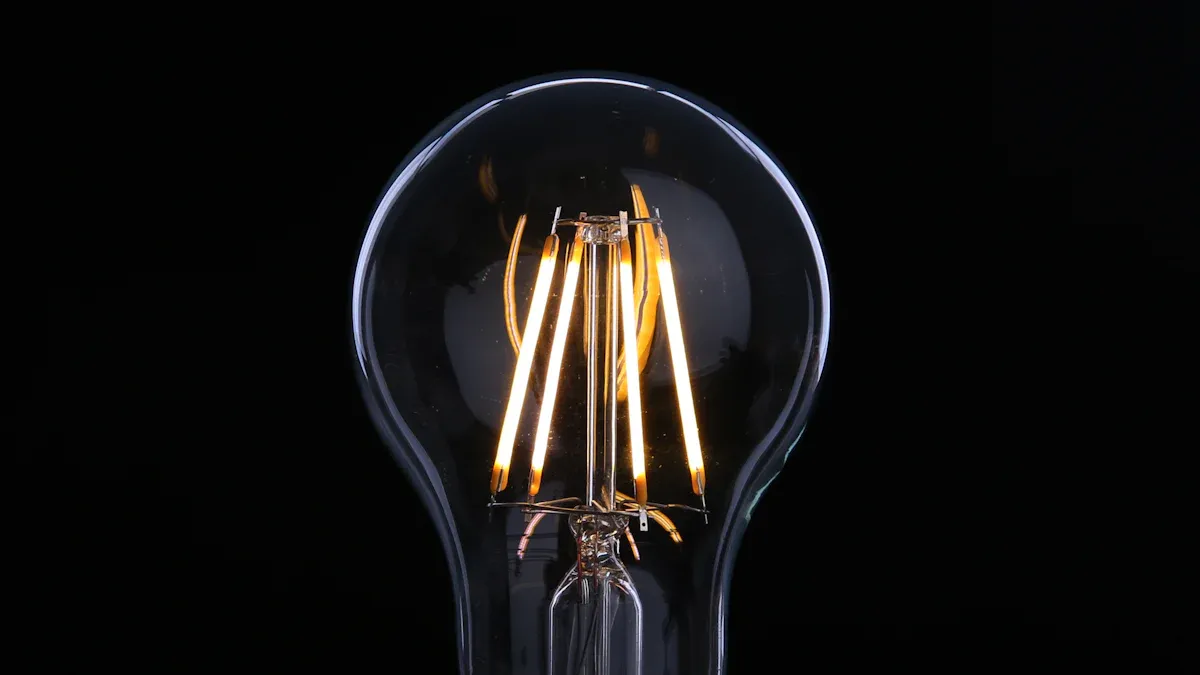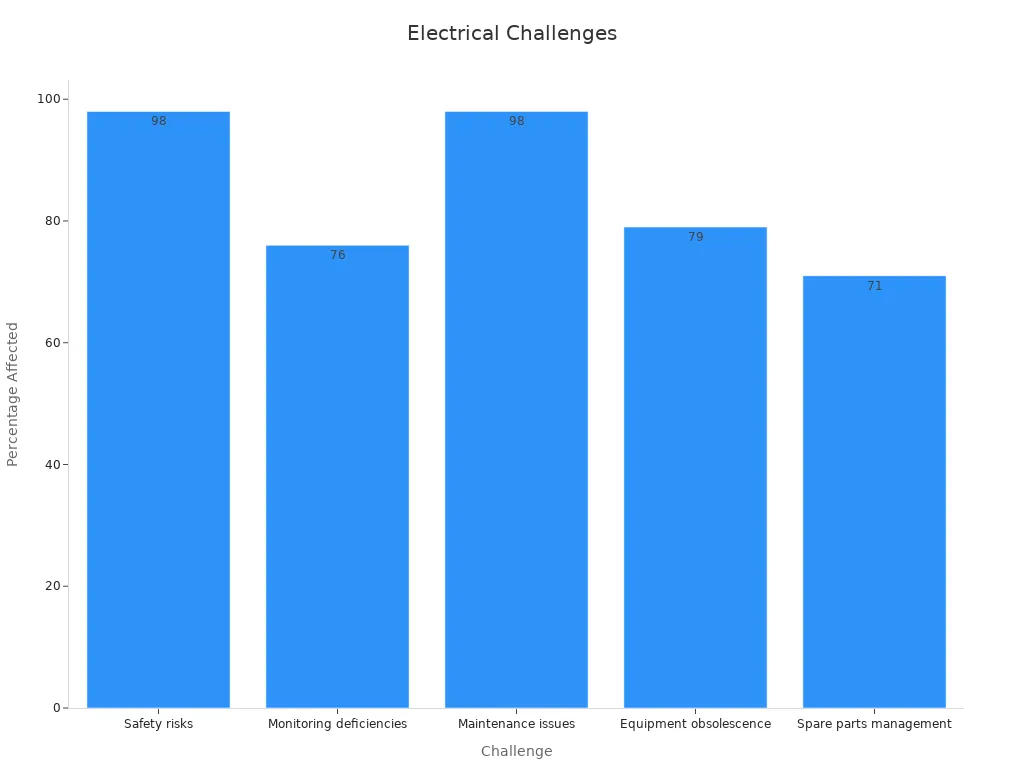Light Commercial Electrical Systems: Integration Strategies for Optimal Lighting Performance

Connecting Light Commercial Electrical Systems is important for better lighting. It helps save a lot of energy and keeps lights steady. Research shows using LED lights can save 50% energy. This big change demonstrates how effective modern lights are. Utilizing systems like Solar Light also benefits the environment. These strategies save money and make spaces greener, supporting eco-friendly goals.
Key Takeaways
Combining light electrical systems saves energy and cuts costs. This helps businesses work better and stay eco-friendly.
Smart lighting tools, like motion sensors and timers, control lights. They stop energy waste and make electricity bills cheaper.
Using sunlight and different light layers boosts comfort and focus. These ideas make workplaces and stores more pleasant.
Energy tracking systems watch usage and guide smart choices. They lower pollution and save money in the long run.
Hiring trained workers ensures systems work well together. Their skills prevent mistakes and improve how things run.
Understanding Light Commercial Electrical Systems
What Are Light Commercial Electrical Systems?
Light commercial electrical systems are made for small businesses. These include stores, offices, and restaurants. They power things like lights, heating, and cooling. They also use tools to save energy and work better.
New technology has improved these systems. For example:
Smart chargers for electric cars help share energy better.
These systems do more than just power devices. They help save money and protect the environment. This makes them great for businesses wanting to go green.
The Role of Integration in Modern Lighting
Connecting systems improves how light systems work. Linking lights with heating and energy tools makes everything run smoothly. Smart systems let you control lights and heating together. This saves energy and gives useful data.
Custom lighting makes spaces better for people. Studies show certain light levels help focus and reduce tiredness. Smart systems can change lights automatically for different tasks.
Integration also helps the planet. LEDs use less energy and last longer. Adding smart controls saves even more energy. This saves money and supports eco-friendly goals.
Using connected systems gives better lighting, saves money, and helps the environment.
Strategies for Better Lighting Performance
Smart Lighting Controls
Smart lighting controls help manage lights in smart ways. These systems use tools like sensors, timers, and automation. They adjust lights based on people, sunlight, or tasks. Adding these controls to electrical systems saves energy and works better.
For example:
Motion sensors turn lights on only when someone is there.
Timers set lights to match business hours.
Sunlight sensors dim lights when there’s enough natural light.
These ideas save energy and make spaces more comfortable.
Here’s how much energy different controls can save:
Lighting Control Type | Energy Saved (%) |
|---|---|
Common Lighting Control | 24-38 |
Sunlight-Responsive Control | 28 |
Task-Specific Tuning | 36 |
Smart controls can also connect to building systems. This gives data about energy use and room activity. Upgrading to these systems can cut energy use by 75%. They pay for themselves in less than three years. This makes them a smart way to save money and improve lighting.
Energy Control Systems
Energy control systems (EMS) help manage energy in buildings. They collect data from smart meters to track energy use. One smart meter can make 35,000 data points each year. This data helps make better choices about energy.
EMS lowers pollution caused by energy use. It reduces energy during busy times and uses less fossil fuel. This helps the planet and saves money.
Important EMS facts:
Data Point | What It Means |
|---|---|
35,000 | Data points from one smart meter yearly |
Millions | Customers adding to big data |
New EMS tools work better and are more reliable. They help businesses save money and stay ahead. Energy checks show how well EMS works. These checks follow ISO 50001 rules and prove energy savings.
Audit Goal | What It Checks |
|---|---|
ISO 50001 Compliance | Meets energy system rules |
Energy Goals | Reaching energy-saving targets |
System Effectiveness | How well the system works |
Energy Savings | Proof of energy improvements |
Using Natural Light and Layered Lighting
Using natural light and layered lighting saves energy and improves spaces. Natural light systems use sensors to adjust indoor lights. This lowers energy use and makes rooms feel better.
Layered lighting mixes different light types like general, task, and accent lights. This setup gives the right light for each activity. It boosts focus and comfort.
Studies show these methods work well. For example, natural light systems improve energy use in buildings. Smart tools predict energy needs based on windows and sunlight.
Study Topic | Results | Meaning |
|---|---|---|
Energy Use Predictions | Smart tools predict energy needs well. | Shows natural light saves energy. |
Real-life examples show the benefits of natural light. Stores with more daylight sold 50% more. Schools with daylight had better student results.
Study | Results |
|---|---|
Wal-Mart Daylight Study | |
School Daylight Study | Better student performance |
Adding natural light and layered lighting to systems saves energy and helps people. These ideas cut costs and support a greener future.
Benefits of Integration Strategies

Energy Efficiency and Reduced Costs
Integration strategies help save energy and cut costs. Using smart lighting controls and energy management systems makes energy use better. This lowers electricity bills and saves money. For example, energy-saving devices use less power, which reduces costs.
Here’s a table showing study results about energy savings:
Study | Findings | Impact on Energy Efficiency |
|---|---|---|
Young (2008) | High | |
Li et al. (2019) | New technology uses less electricity. | Moderate |
Olatunde et al. (2024) | Modern devices cut household energy use. | High |
Alt and Stamminger (2024) | Smart designs save more energy. | High |
Sweeney et al. (2013) | Using energy-saving devices reduces energy use. | High |
Moriarty and Honnery (2019) | How people use devices affects energy savings. | Variable |
Programs for saving energy also cost less. For example, electric utility programs cost 2.8 cents per kWh. This is 33% to 50% cheaper than other energy sources. These savings make integration a smart choice for small businesses.
Energy Efficiency Program Type | Average Cost (per unit) | Comparison to Alternatives |
|---|---|---|
Electric Utility | 2.8 cents per kWh | 50% to 33% cheaper than other options |
Natural Gas Utility | 35 cents per therm | Cheaper than average gas price (39 cents per therm in 2013) |
Enhanced User Comfort and Control
Integrated systems save energy and improve comfort. Smart lighting controls let you change light levels for tasks or preferences. This makes spaces better for working, eating, or shopping.
Layered lighting adds comfort by mixing general, task, and accent lights. Each type of light fits its purpose. Task lights help with detailed work. Accent lights make spaces look nice.
Smart systems also give data about energy use and room activity. This helps you manage energy better while keeping spaces comfortable.
Environmental Sustainability
Integration strategies help protect the environment. They lower energy use and waste, reducing your carbon footprint. Tools like carbon footprint checks and energy tests show how green your systems are.
Here are benefits of eco-friendly practices:
Cost Savings: Using less energy saves money.
Better Reputation: Attracts customers who care about the planet.
Competitive Edge: Makes your business stand out.
Following Rules: Meets environmental laws.
Employee Motivation: Inspires workers and attracts talent.
New Ideas: Creates green solutions and business chances.
Other tools check materials, water use, and waste. These help design systems that are better for the planet. Adding sustainable practices to light commercial electrical systems saves money and helps the Earth. This matches the growing need for eco-friendly businesses and products.
Overcoming Challenges in Implementation
Fixing Compatibility Problems
Compatibility problems can happen when connecting electrical systems. These issues may stop work or raise costs. To fix them, follow smart steps for smooth connections.
What It Means | |
|---|---|
Careful Testing | Test often to find and fix problems early. |
Clear Documentation | Keep detailed notes about system parts and how they connect. |
Version Tracking | Use tools to track changes and avoid mistakes. |
Teamwork | Work together to meet connection needs. |
Continuous Testing | Use tools to test and lower risks during updates. |
Smart Error Fixing | Add tools to handle errors without stopping everything. |
Testing and keeping good records are very important. Write down all devices and systems to spot problems early. Teams working together also help meet connection needs. Using testing tools makes the process faster and safer.

Why Skilled Workers Matter
Skilled workers are key to setting up connected systems. Their knowledge ensures systems work well and lowers mistakes. Hiring based on skills, not just degrees, often works better.
Fact | What It Shows |
|---|---|
Skill-based hiring predicts success five times better than degrees. | |
9% | Skill-based hires stay 9% longer at their jobs. |
5.4 years | Companies with job growth keep workers for 5.4 years on average. |
Skilled workers often have certifications proving their abilities. These show they meet industry rules and can handle tough tasks. Hiring skilled people improves system performance and saves money over time.
Handling Starting Costs
Starting costs for system connections can feel high. But planning well helps control spending. Methods like cost tracking and comparing costs to benefits show where money goes.
Method | What It Does |
|---|---|
Cost Tracking | Follows where money is spent in each step. |
Cost vs. Benefit Check | Compares costs to benefits to see if the project is worth it. |
Spending on energy-saving systems and skilled workers costs more at first. But it saves money later. Lower bills, fewer repairs, and better systems make it a smart choice financially.
Connecting light commercial electrical systems changes how energy and lighting work. These ideas save energy, cut costs, and help the planet. Using smart controls, energy systems, and natural light makes spaces useful and eco-friendly.
🌟 Tip: Begin with smart lighting controls. This simple change saves energy and adds comfort.
Start now! These changes help your business and the environment. Every small step helps create a greener world!
FAQ
1. What are the main benefits of integrating light commercial electrical systems?
Integration helps save energy, cut costs, and protect the environment. It also gives better control over lights and energy use. This makes spaces more comfortable and work-friendly. These benefits make your business greener and more efficient.
💡 Tip: Try small changes like smart lighting controls for quick results.
2. How do smart lighting controls help save energy?
Smart lighting controls use tools like sensors and timers. They adjust lights based on people or sunlight. This stops wasting energy and lowers bills. For example, motion sensors turn off lights in empty rooms to save power.
3. Are these systems expensive to set up?
The starting cost might seem high, but savings add up later. Energy-saving systems lower bills and need less fixing. You can also check for rebates or government programs to help with costs.
4. Can these systems be added to older buildings?
Yes, most older buildings can use these systems. Experts check your setup and suggest the best options. This makes sure everything works well without big changes.
🔧 Note: Always hire trained experts for smooth setup and best results.
5. How does integration help the environment?
Integration cuts energy waste and lowers pollution. Systems like daylight use and energy tools save resources. These steps match global green goals and attract eco-friendly customers.
🌱 Reminder: Small eco-friendly actions can make a big difference for Earth.
See Also
Effective Lighting Strategies for Enhancing Business Spaces
Expert Design and Installation of Flood Lighting Systems
Creative Lighting Solutions for Commercial Spaces: Function Meets Style

